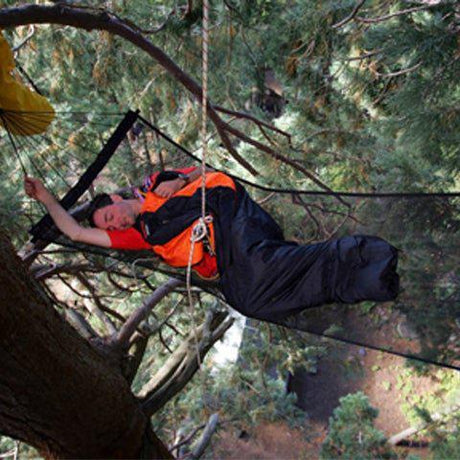When it comes to relaxation and outdoor leisure, few things can beat the comfort and tranquillity of a hammock. Whether you envision yourself swaying gently in the breeze with a good book or taking a nap under the open sky, hammocks offer a unique way to unwind. But before you can start enjoying your hammock, it’s important to know how to hang it safely and how much space you really need.
The right setup isn’t just about comfort, it’s also about safety, durability, and protecting both yourself and your hammock. Let’s break down what you need to consider.
Where Not to Hang a Hammock
You should never hang a hammock on weak, dead, or unhealthy trees, as falling branches can cause serious injury. Avoid trees with cracks, shallow roots, or signs of disease. Hammocks should also not be hung on unstable posts, railings, or structures not designed to support weight. For the safest setup, always choose strong, healthy trees at least 6 inches in diameter—or use a purpose-built hammock stand for maximum stability and comfort.
Hammock Type
The type of hammock you choose affects how much space you’ll need. There are two primary styles:
-
Traditional Hammocks: These classic designs are made of fabric or rope that gathers at each end, creating a natural cocoon. They usually require a minimum of 9–10 feet between anchor points.
See our Rio Bordeaux Hammock £195.10
- Spreader-Bar Hammocks: With wooden or metal bars at each end, these hammocks stay flatter and more open. Because of this design, they need more distance—usually 13–15 feet between anchor points.

Hammock Length
The length of your hammock also affects the space needed for hanging. Longer hammocks provide more room for stretching out and are generally more comfortable. Standard hammock lengths typically range from 10 to 15 feet.
To calculate the minimum distance between anchor points, add about 2 feet to the length of your hammock. So, for a 12-foot hammock, you'll need a space of at least 14 feet between the anchor points. Keep in mind that longer hammocks may require even more space for adequate sag and comfort.
Hammock Sag
Proper hammock sag is essential for comfort and safety. When you lie diagonally in a hammock, your body creates a gentle curve known as the sag. The ideal sag for most hammocks is around 30 degrees. This angle provides the most comfortable and supportive position for relaxation.
To determine the distance between anchor points for the right hammock sag, use the following formula: Hammock Length x 0.83. For example, if your hammock is 12 feet long, you should aim for a distance of approximately 10 feet between the anchor points.
Anchor Points
The anchor points are where you attach your hammock. These can be trees, posts, walls, or dedicated hammock stands. Ensure that your anchor points are sturdy and can bear the weight of the hammock and the person using it.
When using trees, choose healthy and robust ones that are at least 6 inches in diameter to minimize damage to the tree. Ensure that the anchor points are at the appropriate distance apart for your hammock type and length.
Height
Consider the height of your anchor points. The ideal height for hanging a hammock is around 4-6 feet off the ground. This height allows for easy entry and exit and ensures a comfortable swinging motion. Adjust the height according to your preferences and the specific circumstances.
In conclusion, the space you need to hang a hammock depends on the type of hammock, its length, the desired sag, and the location of your anchor points. Taking these factors into account will not only ensure your safety but also maximize your relaxation experience. So, before you embark on your next hammock adventure, measure twice, hang once, and get ready to enjoy the ultimate in outdoor relaxation.
Read more '3-Step Guide to Hanging Your Hammock'



